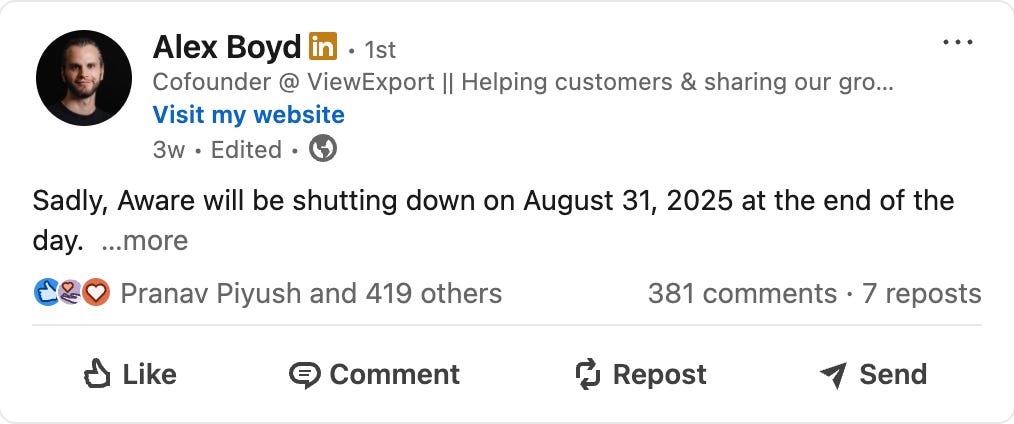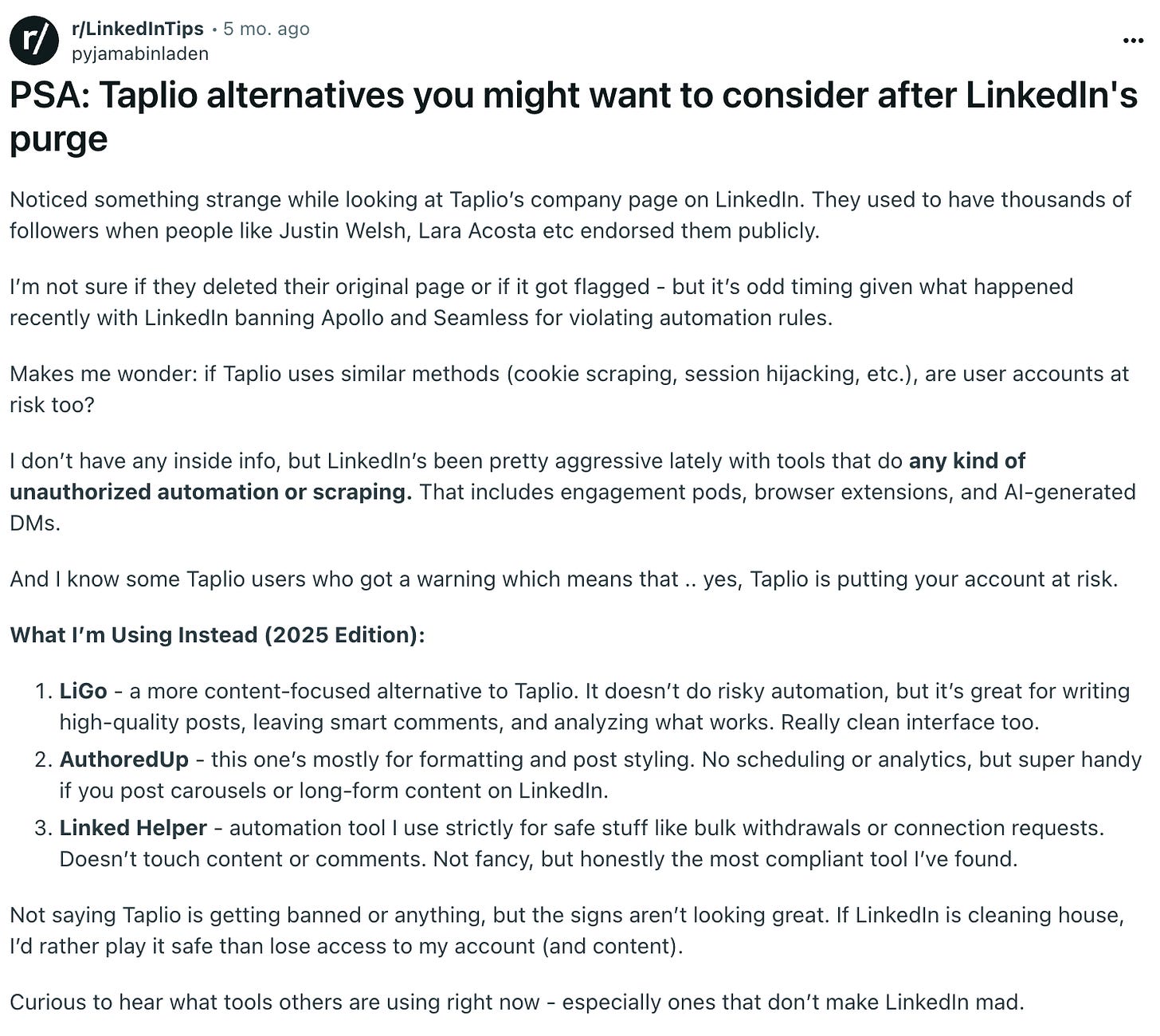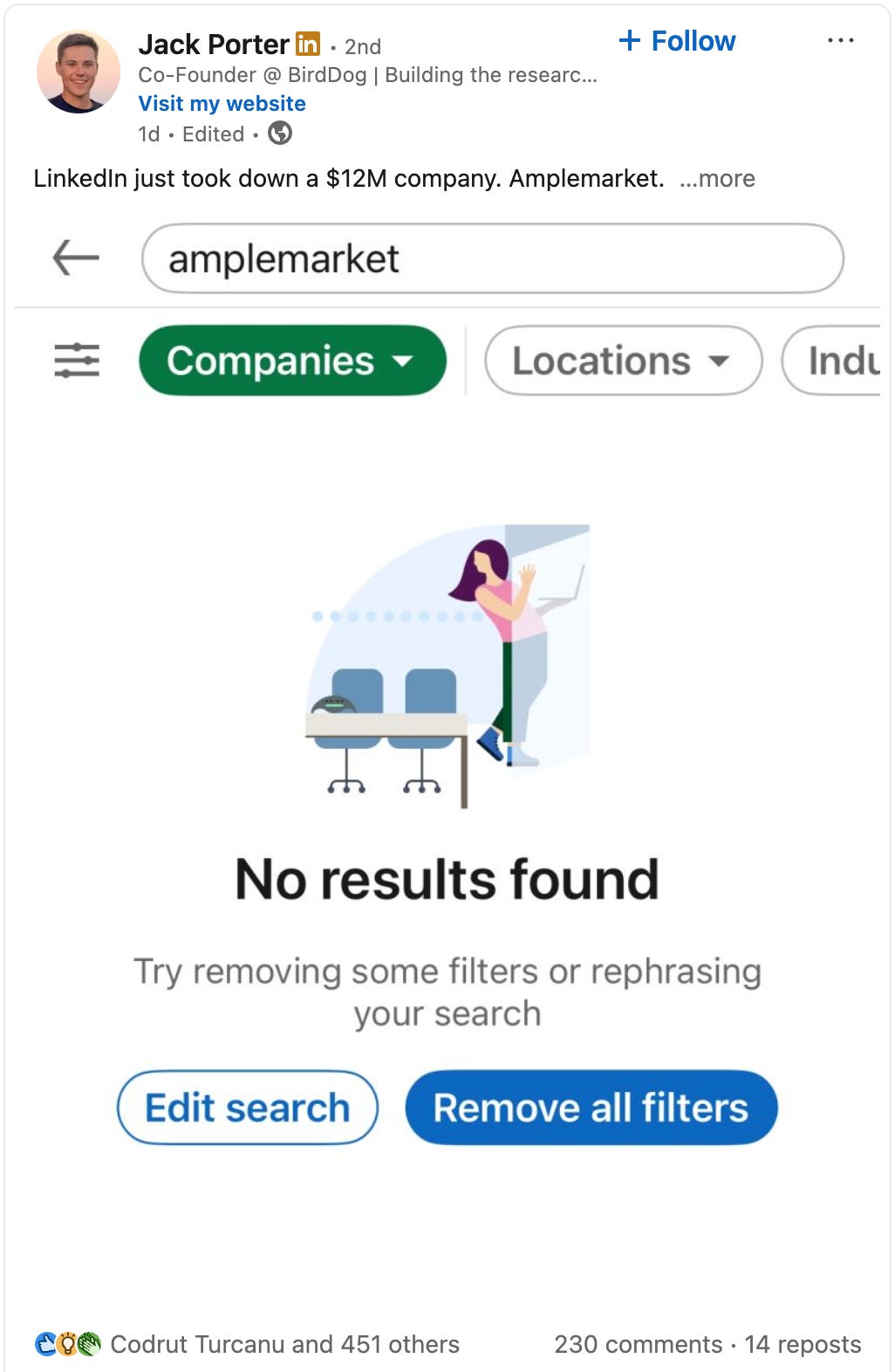Gone baby gone
What the LinkedIn bans say about platform risk in 2025
👋 Hey, I’m George Chasiotis. Welcome to GrowthWaves, your weekly dose of B2B growth insights—featuring powerful case studies, emerging trends, and unconventional strategies you won’t find anywhere else.
This note is brought to you by Above Apex.
When we launched Restartt, one of the first growth levers we wanted to pull was organic search.
To make an impact quickly, you need high-quality, relevant brand mentions and links from trusted websites.
That’s why I partnered with the team at Above Apex. Within weeks, we started landing links like:
Smartsheet (DR 91, 1M+ traffic)
Supademo (DR 71, 40K traffic)
And more.
These are high-authority mentions that tell Restartt's story in the right places.
If you want the same kind of coverage for your brand, book a call here:
Last week, LinkedIn cracked down on another sales tech tool.
And I say “one more” because Amplemarket isn’t the first tool LinkedIn has decided to ban.
Most people think the ban has to do with LinkedIn’s ToS, and that these tools look the other way when it comes to compliance.
I think the truth is a bit more nuanced.
Why do sales tools keep getting banned?
A few months ago, LinkedIn banned Apollo and Seamless AI’s company pages from its platform.
Tim Zheng, Founder and CEO at Apollo, shared an update five days after the ban:

The post focused on how the ban might affect Apollo’s data quality.
According to Tim, there’s no such impact.
Still, it made sense to address it—that’s what customers wanted to know.
Because the assumption is that tools like Apollo rely heavily on LinkedIn data.
And that in most cases, this data is acquired using scraping techniques that don’t comply with LinkedIn’s ToS.
So far, so good.
A few weeks ago, another LinkedIn tool went under.
This time, Aware (domain: useaware.co) had to say goodbye to its customer base and audience.

This wasn’t a (simple) LinkedIn company page ban.
It was a “comply or die” ultimatum that, per the CEO, led them to shut down.
But, of course, Apollo, Seamless AI, and more recently Aware aren’t the only tools that lost the battle against the tech behemoth that is LinkedIn.
Taplio, another tool promising magic for LinkedIn users, also had its page taken down.

After all that, this happened:

Now, yet another sales tool’s LinkedIn page is gone.
I tried searching for the founder’s profile (Luis Batalha), but I can’t find it.
Which means there’s a high chance he was banned too.
Ouch.
That’s not a bootstrapped and proud company.
This is a company that raised a Series A in April 2022, which means it most likely has a board, with participation—besides overpriced advisors who don’t do or know shit—from its investors.
Which means:
Its board, and more specifically, its investors, should have been aware of the company's data-gathering practices.
Look, I’m not saying that they got punished because they’re doing something wrong.
After all, as of writing this note, there hasn’t been an official announcement by the company.
But the pattern is clear.
Sales tools standing on LinkedIn’s shoulders to provide B2B sales data to their customers and getting a slap on the wrist for it.
I’m not judging, and I certainly don’t know the inner workings of these tools.
I also don’t imply that LinkedIn is right here. (In fact, they’re wrong on many different levels.)
Right or wrong, it doesn’t matter.
They have the leverage, and they do things their way.
Which brings me to the most important question:
Why?
That’s (possibly) why
Go check the comments in the posts I shared.
Most people assume that all these bans have to do with LinkedIn ToS.
While in some instances that’s true (e.g., Aware’s former CEO mentioned the company’s inability to comply with LinkedIn’s ToS), that may not always be the case.
I mean, let’s be honest:
SaaS companies (especially VC-backed and under the gun to grow “super fast” ones) are no saints.
They have to move fast, even if they break some things along the way.
This is why these companies are often looking for hacks.
And, sure, on their quest to acquire the ‘1x Exit’ badge for their LinkedIn headline, they may take some shortcuts.
But, if you think about it, that wouldn’t be a problem for LinkedIn, since in the final analysis, these tools—even though pirates—they’re also customers.
They use the product’s API, pay for it, and, of course, may spend money on LinkedIn advertising, and generally re-enforce the creation of an ecosystem in which LinkedIn plays a prominent role.
So, why?
The answer may be simpler than most people think:
1) Content
LinkedIn has to deal with millions of AI-generated words, which explains why you see 3-week-old posts on your feed.
Cracking down on some of these tools (e.g., Taplio) is their way of fighting the issue at its root.
(It’s not, because people will still use AI for writing content, but I won’t expand on that.)
Above all, LinkedIn wants authentic, human-written content on its platform.
2) Monetization
It’s obvious that LinkedIn is becoming a pay-to-play platform.
My feed nowadays looks almost like the feed that pushed me away from Facebook back in the day.
Other users report having a similar experience.
The thing is, LinkedIn doesn’t want there to be shortcuts (e.g., auto commenting) because that impacts their ability to monetize users who struggle with organic reach and have to pay for Thought Leader Ads, Sales Navigator, LinkedIn Premium, etc.
To put it simply (from LinkedIn’s standpoint): “Our users will pay for our tools and not for yours.”
3) Data
LinkedIn has one of the best (if not the best) B2B databases worldwide.
Do you think they’ll let a tool that promises B2B sales awesomeness steal its MOAT, regardless of how much they pay for API credits?
Yeah, I don’t think so.
I can’t blame them regarding this one.
The problem is that in this “war against companies that steal our precious data,” some companies that play by LinkedIn’s own rules will also have to pick up the bill.
And, as an entrepreneur, that’s not something I like.
Ultimately, I don’t see any of these 3 reasons getting better for sales and automation tools.
We’ll see more ‘from 0 to $5M ARR’ tools disappearing overnight, as LinkedIn gets more and more protective over its MOAT and assertive as to how the game should be played.
Final thoughts
So, what does all this mean to you?
Well, platform risk, on a product or an audience level, is real.
On LinkedIn, things are getting tougher.
If you had thoughts about de-resking, now is a good time to do it.
I’m doing the same, by the way.
That’s one reason I write these notes every Tuesday.
Thank you for reading today’s note, and see you again next week.


